| TABLE A Summary of Construction Statistics from Approved Building Permits | |||
|---|---|---|---|
| Philippines : 2018 and 2017 | |||
| (Details may not add up to total due to rounding) | |||
| Type of Construction | 2018 | 2017 | Growth Rate (%) |
| TOTAL | |||
| Number | 173,193 | 152,012 | 13.9 |
| Floor Area (sq.m.) | 41,084,531 | 31,884,027 | 28.9 |
| Value (PHP '000) | 476,008,723 | 333,214,520 | 42.9 |
| RESIDENTIAL | |||
| Number | 126,429 | 110,942 | 14.0 |
| Floor Area (sq.m.) | 22,961,367 | 16,301,228 | 40.9 |
| Value (PHP '000) | 257,417,054 | 164,153,250 | 56.8 |
| NON-RESIDENTIAL | |||
| Number | 24,381 | 21,349 | 14.2 |
| Floor Area (sq.m.) | 17,409,516 | 15,035,707 | 15.8 |
| Value (PHP '000) | 181,481,663 | 143,315,470 | 26.6 |
| ADDITIONS | |||
| Number | 5,769 | 5,086 | 13.4 |
| Floor Area (sq.m.) | 713,648 | 547,092 | 30.4 |
| Value (PHP '000) | 6,768,120 | 4,301,000 | 57.4 |
| ALTERATION AND REPAIR | |||
| Number | 16,614 | 14,635 | 13.5 |
| Value (PHP '000) | 30,341,886 | 21,444,800 | 41.5 |
Number of constructions expands by 13.9 percent
The total number of constructions from approved building permits issued by Local Building Officials (LBOs) for the year 2018 reached 173,193. This number is higher by 3.9 percent from the 152,012 constructions recorded in 2017. (Table A)
By type of construction, residential had the highest number of 126,429 or 73.0 percent of the total constructions. This translates to a growth rate of 14.0 percent from the 110,942 residential constructions reported in 2017. Except other residential, all types of residential constructions registered positive growth rate: residential condominium (90.4%), apartment/accessoria (29.0%), duplex/quadruplex (25.7%) and single-type houses (11.7%). (Tables A and A.1)
Among residential constructions, single-type house reported the highest number of constructions of 106,487 or 84.2 percent of the total residential constructions. This was followed by apartment/accessoria with17,304 constructions (13.7%) and duplex/quadruplex-type with 2,208 constructions (1.7%). (Figure 1)
Non-residential construction placed second at 24,381 or 14.1 percent of the total constructions. This figure is up by 14.2 percent from the 21,349 constructions recorded in 2017. The type of non-residential constructions that contributed to the increase were institutional (35.2%), commercial (11.7%), agricultural (5.6%) and industrial (2.7%). On the other hand, other non-residential constructions registered a decrease of 4.4 percent, from 574 in 2017 to 549 constructions in 2018. (Tables A and A.1)
By type of non-residential construction, commercial building construction registered the most number of constructions with 14,674 or 60.2 percent of the total non-residential constructions. This was followed by institutional buildings with 5,338 (21.9%) constructions and industrial buildings with 2,649 (10.9%) constructions. (Figure 1)
The number of additions to existing structures was recorded at 5,769 (3.3%), higher by 13.4 percent from the 5,086 constructions recorded in 2017. Similarly, the combined number of alterations and repairs of existing structures at 16,614 (9.6%) increased by 13.5 percent, from 14,635 projects in the previous year. (Tables A and A.1)
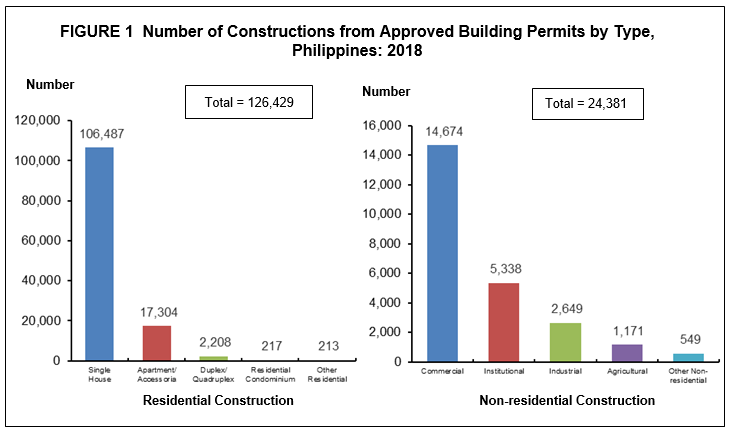
The total number of constructions for the top five regions comprised 63.6 percent of the total constructions in 2018. Number of constructions in CALABARZON remained the highest at 43,929 or 25.4 percent of the total. Central Visayas ranked second with 20,397 (11.8%) constructions. Other regions in the top five were: Central Luzon, 18,778 (10.8%), National Capital Region, 14,094 (8.1%) and Western Visayas, 13,012 (7.5%) of the total. (Figure 2)
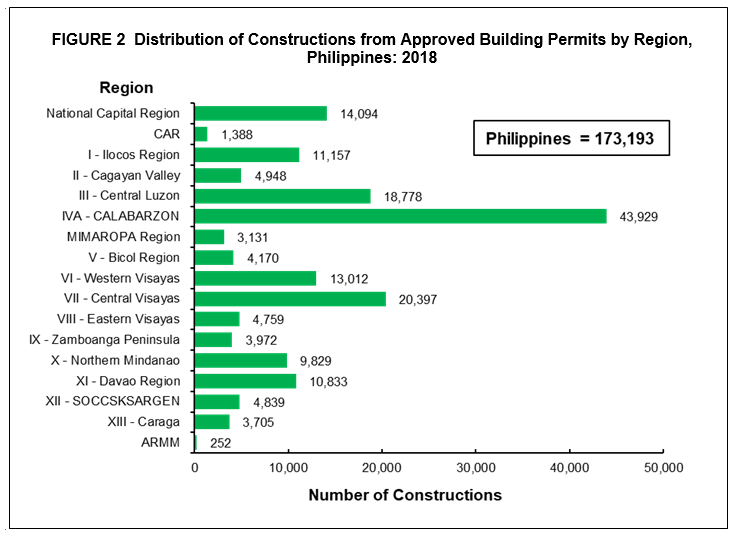
At the provincial level, the top five provinces accounted for 46.1 percent of the total constructions. Cavite, with 20,779 constructions, continued to account for the biggest share of 12.0 percent in 2018. Cebu with 8,339 constructions (4.8%) ranked second, followed by Batangas with 7,786 (4.5%). Completing the top five provinces were Laguna with 7,159 constructions (4.1%) and Bulacan with 6,611 constructions (3.8%). (Table 1)
Total value of constructions increases by 42.9 percent
In 2018, the total value of construction was estimated at PHP476.0 billion, higher by 42.9 percent compared with the PHP333.2 billion reported value during the previous year. (Table A)
The total value of residential constructions (PHP257.4 billion) accounted for more than half (54.1%) of the total value of construction in 2018. This value represents an increase of 56.8 percent from the construction value of PHP164.2 billion in 2017. The increase in the total value of residential constructions was attributed to the expansion of residential condominiums at 153.7 percent, followed by duplex/quadruplex (41.8%), apartment/accessoria (39.7%) and single-type house (15.2%). On the other hand, the value of other residential constructions (PHP407,770) decreased by 43.7 percent from PHP724,229 in 2017. (Table A.1)
Value of non-residential building constructions amounted to PHP181.5 billion, an increase of 26.6 percent, from PHP143.3 billion in 2017. The growth was brought about by the double-digit increase in the construction values of the following: institutional (43.0%), industrial (23.9%) and commercial (23.2%) buildings.
Similarly, construction values for additions to existing structures in 2018 amounting to PHP6.8 billion or 1.4 percent of the total construction value, increased by 57.4 percent from the PHP4.3 billion posted value in 2017. Combined construction values of alteration and repair of existing structures, estimated at PHP30.3 billion (6.4%), went up by 41.5 percent, from PHP21.4 billion in 2017. (Figure 3 and Table A.1)
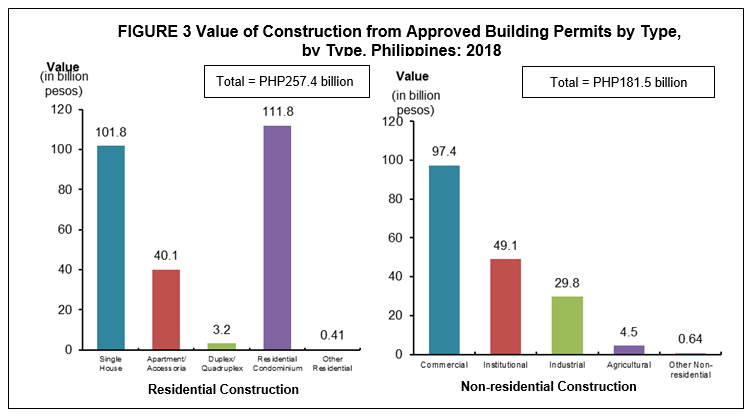
Region-wise, the combined shares of the top five regions (PHP368.4 billion), comprised 77.4 percent of the total value of construction. NCR, which ranked fourth in terms of the number of constructions, reported the highest value of construction at PHP164.0 billion or 34.4 percent of the total. (Figure 4)
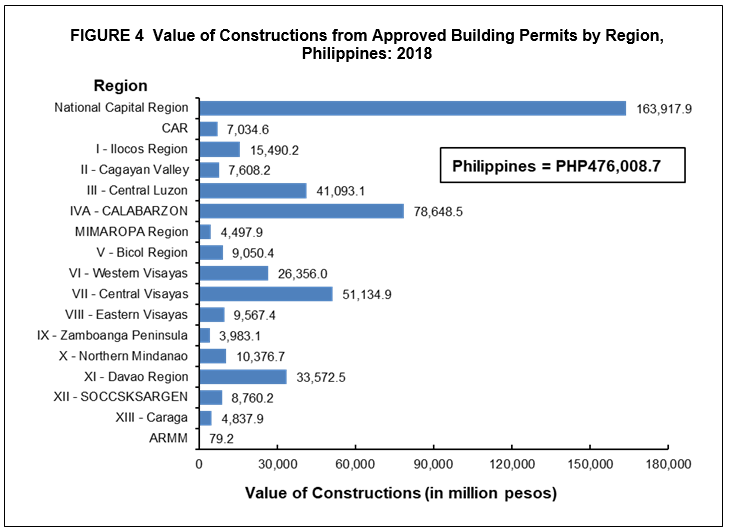
Other regions in the top five were:
- CALABARZON, PHP78.6 billion (16.5%)
- Central Visayas, PHP51.1 billion (10.7%)
- Central Luzon, PHP41.1 billion (8.6%)
- Davao Region, PHP33.6 billion (7.1%)
Average costs of residential and non-residential building constructions increase
Residential building constructions in 2018 had an average floor area of 181.6 square meters per building and an average cost of PHP11,211 per square meter. The average cost is 11.3 percent higher than the previous year’s average cost of PHP10,070 per square meter. The growth was due to the increases in the average cost per square meter of duplex/quadruplex (12.7%), apartment/accessoria (6.3%), single-type (3.1%) and residential condominiums (0.7%). (Figure 5 and Table A.1)
Among residential constructions, residential condominiums recorded the highest average cost of PHP15,342 per square meter. This type of residential construction had an average floor area of 33,584.6 square meters per building. Duplex/quadruplex-type dwellings registered the second highest with an average cost of PHP10,107 per square meter and an average floor area of 148.3 square meters per building. Other residential constructions ranked third with an average cost of PHP9,560 per square meter and an average floor area of 200.2 square meters per building. (Figure 5 and Table A.1)
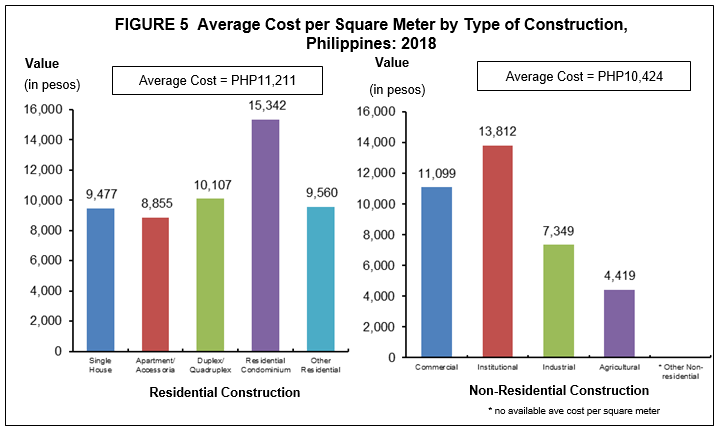
Non-residential building constructions in 2018 had an average floor area of 714.1 square meters per building and an average cost of PHP10,424 per square meter. The average cost is 9.4 percent higher than the average cost of PHP9,532 per square meter in the previous year. This was attributed to the increases in the average cost per square meter of institutional (15.1%), industrial (12.6%) and commercial (5.3%) buildings. (Table A.1)
Among non-residential constructions, institutional-type reported the highest average cost of PHP13,812 per square meter. This type of non-residential construction reported an average floor area of 666.0 square meters per building. Commercial-type building followed with an average cost of PHP11,099 per square meter and an average floor area of 598.2 square meters per building. Industrial-type buildings ranked third with an average cost of PHP7,349 per square meter and an average floor area of 1,529.9 square meters per building. (Figure 5 and Table A.1)
(Sgd) ROSALINDA P. BAUTISTA
Assistant Secretary
Deputy National Statistician
Sectoral Statistics Office
TECHNICAL NOTES
CONSTRUCTION STATISTICS FROM APPROVED BUILDING PERMITS
Introduction
This Special Release presents the final annual data on construction statistics from approved building permits for the year 2018. The final annual data includes additional approved building permits collected after the monthly cut-off date. Annual final tables are presented in annual, quarterly and monthly tables by region and province.
Scope and Coverage
Construction statistics presented in this special release are based on approved building permits for new constructions and additions, alterations and repairs of existing residential and non-residential buildings, and other structures which are proposed to be constructed in the different cities/municipalities of the country.
Sources of Information
Construction statistics are generated from approved building permits as well as from the demolition and fencing permits collected every month by PSA field personnel from the Offices of Local Building Officials (LBOs).
Limitations of Data
1. Data on building constructions are based from approved applications for construction during the reference period and not on the construction work completed during the reference period.
2. The completeness of construction data relies on the approved applications filed with the LBOs. Hence, building constructions without approved building permits are excluded in the tabulation of data.
Geographic Classification
For 2018, building constructions are classified and presented by geographic area using the Philippine Standard Geographic Classification (PSGC) as of December 2017.
Statistics Generated
Construction statistics generated from approved building permits provide monthly data on building construction at the regional and provincial levels. The statistics generated are the following:
• number
• floor area
• type of construction
• value of construction
Aside from the preliminary tables posted in the PSA website, the annual, quarterly and monthly statistical tables at the municipality level by type of construction are available at the Industry Statistics Division (ISD) under the Economic Sector Statistics Service (ESSS) of the PSA.
Dissemination
Annual final results of construction statistics are made public in the form of Annual Special Release. The Annual Special Release is a consolidated report of the quarterly preliminary data including data from approved building permit applications which were submitted after the cut-off date of each month. This is posted eight months after the reference year at the PSA website (www.psa.gov.ph).
Definition of Terms (Adopted from the Revised and Updated IRR of the National Building Code)
Building permit is a written authorization granted by the LBO to an applicant allowing him to proceed with the construction of a specific project after plans, specifications and other pertinent documents have been found to be in conformity with the National Building Code (PD 1096).
Building refers to any independent, free-standing structure comprised of one or more rooms or other spaces, covered by a roof and enclosed with external walls or dividing walls, which extend from the foundation to the roof.
Construction refers to all on-site work done from site preparation, excavation, foundation, assembly of all the components and installation of utilities, machineries and equipment of buildings/structures.
Residential building is a building for which its major parts or more than half of its gross floor area is built for dwelling purposes. This type of building can be single, duplex, apartment and/or accessoria, and residential condominium.
Single house is a complete structure intended for a single family or household, i.e., bungalow, 2-storey house, nipa hut, etc.
Duplex house is a structure intended for two households with complete living facilities for each; it is a single structure divided into two dwelling units by a wall extending from the floor to the ceiling.
Apartment is a structure, usually of two storeys, made up of independent living quarters, with independent entrances from internal walls and courts.
Accesoria is a one or two-floor structure divided into several dwelling units, each dwelling unit having its own separate entrance from the outside.
Residential condominium is a structure, usually of several storeys, consisting of multiple dwelling units.
Other residential construction consists of school or company staff houses, living quarters for drivers and maids, and guardhouses.
Non-residential building includes commercial, industrial, agricultural and institutional buildings.
Commercial buildings refer to office buildings and all buildings which are intended for use primarily in wholesale, retail and service trades; i.e., stores, hotels, restaurants, banks, disco houses, etc.
Industrial buildings are buildings used to house the production, assembly and warehousing activities of industrial establishments, i.e., factories, plants, mills, repair shops, machine shops, printing press, storage plant, electric generating plants.
Institutional buildings are buildings which primarily engaged in providing educational instructions and hospital/health care; ports, airports and other government buildings; i.e., school, museums, libraries, sanitaria, churches, hospitals.
Agricultural buildings are buildings used to house livestocks, plants and agricultural products such as barn, poultry house, piggeries, stables, greenhouses and grain mill.
Other non-building constructions include cemetery structures, street furniture, waiting sheds, communication towers, etc.
Addition refers to any new construction which increases the height or area of an existing building/structure.
Repair is a remedial work done on any damaged or deteriorated portion/s of a building/structure to restore its original condition.
Renovation is any physical change made on structures to increase their value and quality, and to improve their condition.
Alteration is a construction in a building/structure involving changes in the materials used, partitioning and location/size of openings, structural parts, existing utilities and equipment but does not increase the overall area thereof.
Conversion is a change in the use or occupancy of structure or any portion thereof, which has different requirements.
Demolitions refer to the systematic dismantling or destruction of a building/structure, in whole or in part.
Street furnitures are street structures consisting of monuments, waiting sheds, benches, plant boxes, lampposts, electric poles and telephone poles.
Floor area of building refers to the sum of the area of each floor of the building measured to the outer surface of the outer walls including the area of lobbies, cellars, elevator shafts and all communal spaces in multi-dwellings. Areas of balconies are excluded.
Total value of construction refers to the sum of the cost of building, electrical, mechanical, plumbing, and others. The value is derived from the approved building permit and represents the estimated value of the building or structure when completed.
